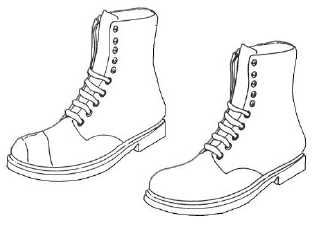TM 9-243
Section II.
SAFETY RULES (POWER TOOLS)
Safety is a very important factor in the use of power tools
and cannot be overemphasized. By observing the fol-
lowing safety guidelines, you can ensure maximum
benefits from the tools you use and reduce to a minimum
the chances of serious injury.
1.
2.
3.
4.
5.
6.
7.
8.
Never operate any power equipment unless you
are completely familiar with its controls and
features.
Inspect all portable power tools before using them.
See that they are clean and in good condition.
Make sure there is plenty of light in the work area.
Never work with power tools in dark areas where
you cannot see clearly.
Before connecting a power tool to a power source,
be sure the tool switch is in the “OFF” position.
When operating a power tool, give it your FULL
and UNDIVIDED ATTENTION.
DO NOT DISTRACT OR IN ANY WAY DISTURB
another person while they are operating a power
tool.
Never try to clear a jammed power tool until it is
disconnected from the power source.
After using a power tool, turn off the power, dis-
connect the power source, wait for all movement of
9.
10.
11.
12.
13.
14.
the tool to stop, and then remove all waste and
scraps from the work area. Store the tool in its
proper place.
Never plug the power cord of a portable electric
tool into a power source before making sure that
the source has the correct voltage and type of
current called for on the nameplate of the tool.
Do not allow power cords to come in contact with
sharp objects, nor should they kink or come in
contact with oil, grease, hot surfaces, or
chemicals.
Never use a damaged cord. Replace it
immediately.
Check electrical cables and cords frequently for
overheating. Use only approved extension cords,
if needed.
See that all cables and cords are positioned care-
fully so they do not become tripping hazards.
Treat electricity with respect. If water is present in
the area of electrical tool operation, be extremely
cautious and if necessary, disconnect the power
tool.
Section Ill. SAFETY EQUIPMENT
Safety equipment is for you. It will protect you from injury
and may possibly save your life. Some of the more
common types of safety equipment for your personal
protection follow.
Safety shoes protect and prevent injury or loss of toes.
Some safety shoes are designed to limit damage to your
toes from falling objects. A steel plate is placed in the toe
area of such shoes so that your toes are not crushed if
an object falls on them. Other safety shoes are designed
SAFETY SHOES
for use where danger from sparking could cause an
explosion. Such danger is minimized by elimination of
all metallic nails and eyelets and the use of soles which
do not cause static electricity.
2-3

